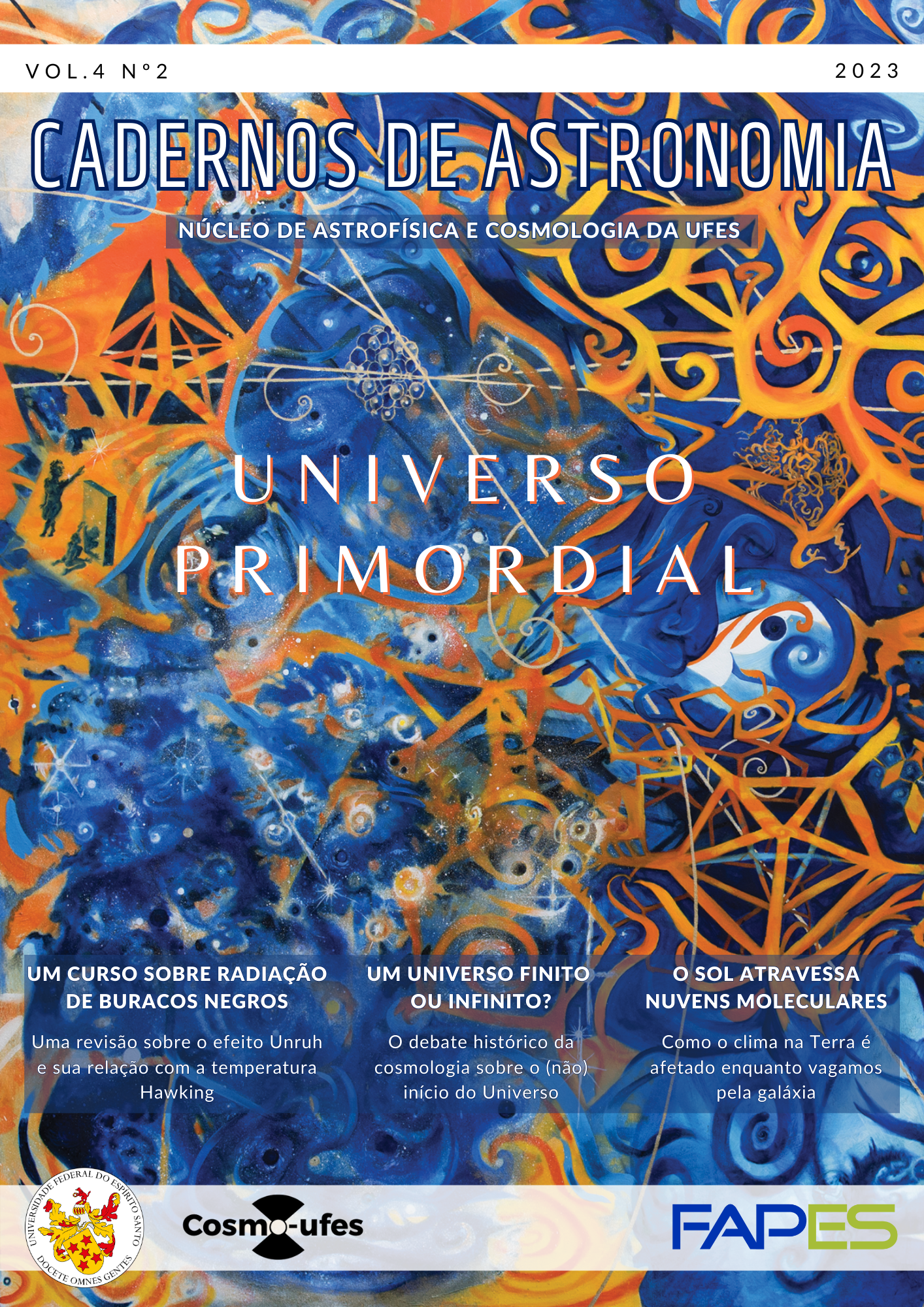The Fulling-Davies-Unruh effect
DOI:
https://doi.org/10.47456/Cad.Astro.v4n2.42121Keywords:
Unruh effect, Hawking radiation, quantum field theoryAbstract
This text (revised and upgraded) is based on graduate lectures given the author at the Côte d’Azur University on ``Different Aspects of General Relativity''. These lectures were part of a project aiming to integrate the group VIRGO in Nice (occurred in 1996), which was previously in Saclay. The present text is addressed to the Fulling-Davies-Unruh effect and its connection with the Hawking radiation, despite that both phenomena are distinct processes. The understanding of the Fulling-Davies-Unruh effect is fundamental in the field quantization on curved spacetimes, the main objective of this article.
References
S. Hawking, Particle creation by black holes, Comm. Math. Phys 43, 199 (1975).
S. A. Fulling, Nonuniqueness of canonical field quantization in Riemannian space-time, Physical Review D 7(10), 2850 (1973).
P. Davies, Scalar production in Schwarzschild and Rindler metrics, Journal of Physics A: Mathematical and General 8(4), 609 (1975).
W. Unruh, Notes on black hole evaporation, Phys. Rev. D 14, 870 (1976).
S. W. Hawking, Black hole explosions?, Nature 248(5443), 30 (1974).
K. Fredenhagen e . R. Haag, On the derivation of Hawking radiation associated with the formation of a black hole, Comm. Math. Phys 127, 273 (1990).
M. Parikh e . F. Wilczek, Hawking radiation as tunneling, Phys. Rev. Lett 85, 5042 (2000).
R. Banerjee, B. Majhi e . Samanta, Noncommutative black hole thermodynamics, Phys. Rev. D 77, 124035 (2008).
W. G. Unruh e R. M. Wald, What happens when an accelerating observer detects a Rindler particle, Physical Review D 29(6), 1047 (1984).
M. Lynch, Notes on the experimental observation of the Unruh effect, Essay written for the Gravity Research Foundation 2022 Awards for Essays on Gravitation (2022).
B. S. Kay e R. M. Wald, Theorems on the uniqueness and thermal properties of stationary, nonsingular, quasi-free states on spacetimes with a bifurcate Killing horizon, Physics Reports 207(2), 49 (1991).
S. Takagi, Vacuum noise and stress induced by uniform acceleration, Progress of Theoretical Physics Supplement 88, 1 (1986).
T. Fulton e F. Rohrlich, Classical radiation from a uniformly accelerated charge, Annals of Physics 9(4), 499 (1960).
D. G. Boulware, Radiation from a uniformly accelerated charge, Annals of Physics 124(1), 168 (1980).
S. Y. Lin, Classical correspondence of Unruh effect (2001). ArXiv:gr-qc/0105051.
K. Mcdonald, The Hawking-Unruh temperature and quantum fluctuations in particle accelerators (2000). ArXiv:physics/0003060.
J. Bell e J. Leinaas, The Unruh effect and quantum fluctuations of electrons in storage rings, Nucl. Phys. B 284, 488 (1987).
P. Chen e T. Tajima, Testing Unruh radiation with ultraintense lasers, Phys. Rev. Lett 83(2), 256 (1999).
A. A. Sokolov e I. M. Ternov, On polarization and spin effects in the theory of synchrotron radiation, Sov. Phys. Dokl 8, 1203 (1964). Disponível em https://www. mathnet.ru/eng/dan28897, acesso em ago. 2023.
J. Bell e J. Leinaas, Electrons as accelerated thermometers, Nuclear Physics B 212(1), 131 (1983).
E. Akhmedov e D. Singleton, On the relation between Unruh and Sokolov-Ternov effects, International Journal of Modern Physics A 22(26), 4797 (2007).
B. Dewitt, Quantum gravity: the new synthesis , in General Relativity: An Einstein Centenary Survey, editado por S. W. Hawking e W. Israel (Cambridge University Press, 1979), 680.
J. Hu et al., Quantum simulation of Unruh radiation, Nature Physics 15(8), 785 (2019).
V. L. Ginzburg e S. I. Syrovatski ̆ı, Cosmic Magnetic Bremsstrahlung (Synchrotron Radiation), Soviet Physics Uspekhi 8(5), 674 (1966).
R. Müller, Decay of accelerated particles, Phys. Rev. D 56(2), 953 (1997).
D. A. T. Vanzella e G. E. A. Matsas, Decay of accelerated protons and the existence of the Fulling-Davies-Unruh effect, Physical Review Letters 87(15), 151301 (2001).
D. A. T. Vanzella e G. E. A. Matsas, Weak decay of uniformly accelerated protons and related processes, Physical Review D 63(1), 014010 (2001).
Downloads
Published
Issue
Section
License
Copyright (c) 2023 José A. F. Pacheco

This work is licensed under a Creative Commons Attribution 4.0 International License.






